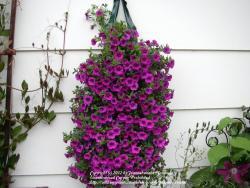Some info about petunias
They are actually evergreen perennials, hardy to Zone 9A. Very common and suitable to use as “Annuals” in colder climates. Most varieties available are hybrids: Petunia x hybrida,
Propagation
• Vegetative: propagated by stem cuttings. Reasons could be the plant produces sterile seed or doesn’t come true from seed. Patent pending etc. These are usually available as plants only
• Seed varieties are usually available by single variety or selected mixes. These are available as plants and/or seed packages
Daylight Neutral
• If the petunia is daylight neutral or semi-neutral, it will develop flower buds during short days in early spring and late fall. (less than 12 hour daylight)
Deadheading
• Many new varieties are “Free-Flowering”, which means they do not need to be deadheaded to encourage new flower bud formation. Some do need to be tidied up if the flowers don’t shed off.
Color
• Petunia “Purple” is more of a Magenta color. Petunia “Blue” looks deep blue-lavender, or dark royal purple. “Morn” is tri-color with the base color + White throat + Yellow center. Many colors change with temperatures and sunlight conditions. Bi-Colors, such as Sophistica Lime Bi-Color may have an irregular pattern
Bloom Patterns
• Star is usually base color with a White star. Petunia x hybrida Phantom is unique with near-Black base color and a Yellow star
• Picotee, Frost, Hulahoop all have base color with White edge. Supertunia Pretty Much Picasso is a Fuchsia base with Lime Edge
• Vein, Lace, Crystal and Ice are typically base color with dark veins. Daddy series are all veined.
Growth Habit
• Upright: about the same H x W good for planters or in ground
• Round or Bubble: slightly wider than high to give a round display
• Mounding: keeps height in the center, good for planters or in ground or more compact looking basket
• Mounding Spreading/Trailing: Stays about 10” to 14” high with 2’ + stems. Best choice for hanging basket
• Spreading/Trailing: Long stems, usually only 6” to 8” high with over 2’+ stems. Will sprawl in ground and drape in a basket
• Rule of thumb for # plants per basket: The number of plants is about half the diameter. So a 12” basket will do well with 5-6 plants (excluding Tidal Waves).
Flower Size
Milliflora: less than 2” small
Multiflora: about 2.5” medium
Floribunda: about 3” large
Grandiflora: 3.5” to 4” extra-large
Determinate versus Indeterminate for amount of flowers per stem
99.9% of the "Double" Flower petunias have one bloom at the end of the stem
Most of the Single Flower petunias are Indeterminate and have multiple blooms along the last section of the stem
“Compact” The plant is not small. Compact refers to a tight growth habit. Short internodes
“Dwarf” usually refers to the plant not the flower
“Vigorous” Strong stems and often longer internodes. Usually spreading or trailing types
I used a lot of these terms in the ATP database. Hope it helps
Petunia"BLUE"

Petunia"Blue Vein"
Petunia "PINK MORN"

Petunia "PURPLE"

